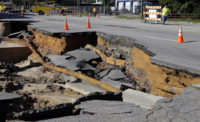With the death toll now rising almost as fast as the waters that carried away the victims, last weekends Asian tidal wave has already gained the status as one of the most deadly episodes in natural history. Such disasters inevitably spark the imagination to contemplate still more dire events that may lie ahead, including the prospect of thousand-foot waves from Boston Harbor to Biscayne Bay.
Not even the most alarmist researchers have said that was possible. But that doesnt stop people from suggesting it is true.
What, wondered author Dennis Smith in the Dec. 28 issue of the New York Times, if the tempo of terrestrial upheaval beats faster than scientists have discerned? And what if newly discovered fault lines beneath the volcano on La Palma, in the Canary Islands, causes the crater to break apart and slide into the Ocean? The landmass would displace enough water to send a tsunami rolling toward the Eastern U.S.
if it hit the Atlantic Seaboard it could be higher than the skyscrapers of Boston, New York, Washington and Miami. Scientists do not know if it will take one, four, or 10 eruptions to separate the landmass, only that the separation is inevitable.
Smith recommends reducing the landmass at the La Palma volcanoit would be one of the greatest excavation and grading projects of all timebut wonders who will pay.
Thoughtfulness following a disaster is welcome, but imaginations unbound by science can create false ideas or inspire fear.Not even the researchers whose work is the basis for recent doomsday writings believe thousand foot waves would batter the Eastern U.S.
In 2001, geologists Steven N. Ward and Simon Day wrote that a landslide that causes a collapse of the west flank of Cumbre Vieja Volcano on La Palma could generate waves that arrive on the coasts of the Americas as much as 70 ft in height. The scientists had used modeling techniques to produce their conclusion. At the end of their paper, they describe an arc of destruction never witnessed. A great train of dispersed waves 500 km across develops as the tsunami moves into the Atlantic basin. While Spain and England experience 5 to 7 m waves, the vanguards of the tsunami arrive in Newfoundland at 10 m. At 9 hours after the triggering landslide, Florida faces waves of 70 ft parading in a dozen cycles or more.
|
Both scientists cautioned that the chances of such an event were miniscule. Lets not scare people, Ward told the Associated Press. Certainly there is no indication that this will happen anytime soon.
Even when there is an eruption, the probability of collapse [of the volcano] is low, Day added.
In the hands of excitable journalists, Ward and Days research was nothing less than a vision of apocalypse. According to their model, 70 ft waves would indeed wreck much of the Coastal seaboard. But a CNN story that appeared in August, 2001, put the height of Ward and Days waves at more than 15 stories. A wall of water 164 ft highhigher than Nelsons column in Londons Trafalgar Squarewould smash into the coasts of Florida and Caribbean islands, the forecast predicts.
There was more to come. The Discovery Channel aired a program in the following months describing possible mega-tsunamis that could destroy coastal areas of the U.S.
To settle the fears and end scaremongering, the Tsunami Society, a research group, published a reply on Jan. 15, 2003.The society said the Cumbre Vieja Volcano on Las Palma was unlikely to destroy much of the world.
It will not send a large part of the island into the ocean, though small landslides may occur, the Society wrote. Models of the collapse on Las Palma have shown that relatively short waves from small, though intense landslides do not travel in the same way as tsunami waves from major earthquakes, the Society said.
So far, only writers unwilling to multiply or check sources have suggested waves greater than 70 ft are remotely possible. Yet their stories appear in major media.
Volcanic collapses are among the rarest of geologic events, even if the tempo of terrestrial upheaval is much faster than anyone now knows. If we were to try to mitigate the hazard to the east coast of the U.S., the first step will be more careful monitoring and study. The doomsday tsunami isnt quite so big and bad as some have written. And it is unlikely to arrive tomorrow or even the day after tomorrow, geologically speaking.
Links
Ward and Days Paper on the potential collapse and tsunami at La Palma, Canary Islands - www.es.ucsc.edu/~ward/papers/La_Palma_grl.pdf
Tsunami Society statement on Discovery Channel program www.sthjournal.org/media.htm




Post a comment to this article
Report Abusive Comment